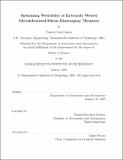Optimizing wettability of externally wetted microfabricated silicon electrospray thrusters
Author(s)
Garza, Tanya Cruz
DownloadFull printable version (1.500Mb)
Other Contributors
Massachusetts Institute of Technology. Dept. of Aeronautics and Astronautics.
Advisor
Manuel Martínez-Sánchez.
Terms of use
Metadata
Show full item recordAbstract
Electrospray propulsion devices with externally wetted architectures have shown favorable performance. The design of microfabricated silicon thrusters and their feed systems requires an understanding of propellant flow over a silicon surface. This research explores the parameters that affect wettability of externally wetted microfabricated silicon electrospray thruster arrays and how varied wetting surface treatments affect thruster performance. Silicon samples with various black silicon treatments were fabricated and optimal black silicon etch parameters were determined by measuring the samples wettability. Silicon wettability was analyzed by producing samples with various black silicon treatments and then measuring contact angle, measuring surface roughness, imaging surface geometry, calculating spreading rates, and performing treated thruster current output tests. Two propellants, 1-ethyl-3-methyl-imidazolium tetraflouroborate (EMI-BF4) and 1-ethyl-3-methyl-imidazolium bis(triflouromethyl-sulfonyl)amide (EMI-IM), were used in contact angle measurements and spreading rate experiments. A model describing the spread of a small drop of EMI-BF4 and EMI-IM over roughened silicon substrates is presented. (cont.) Models which describe the spread of small, non-reactive drops over perfectly smooth substrates predicts a 1/5th power dependence of spreading area with time. Experimental spreading data of EMI-BF4 loosely supported this theory showing an average of 1/3rd power dependence of spread area with time. A model of propellant spreading is proposed here suggesting that viscous spreading reaches an equilibrium with constant radius and provides a capillary pressure source for porous flow through the black silicon surface for the remainder of the spreading. This theory is compared with experimental data of EMI-BF.K and EMI-IM propellant spread over roughened silicon. Future work in propellant supply to a thruster surface is discussed. Theoretical and experimental areas of study are proposed to understand physical flow mechanisms involved in electrospray thrusters.
Description
Thesis (S.M.)--Massachusetts Institute of Technology, Dept. of Aeronautics and Astronautics, 2007. This electronic version was submitted by the student author. The certified thesis is available in the Institute Archives and Special Collections. Includes bibliographical references (leaves 67-70).
Date issued
2007Department
Massachusetts Institute of Technology. Department of Aeronautics and AstronauticsPublisher
Massachusetts Institute of Technology
Keywords
Aeronautics and Astronautics.